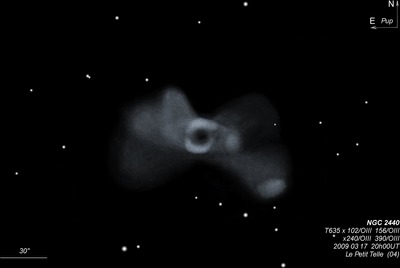
William Herschel discovered NGC 2440 = H IV-64 = h3095 on 4 Mar 1790 (sweep 934) and described a "beautiful planetary nebula of a considerable degree of brightness, but not very well defined. About 12 or 15" in diameter."
William Lassell observed NGC 2440 in Jan 1853 with his 24-inch equatorial reflector on Malta. He commented, "no description can do justice to this singular object. With 150 it just attracts the eye in sweeping, as a a bluish-white spot, a few seconds in diameter. A most extraordinary object [at 650x], not beautiful, for it has no symmetry – but wonderful." His sketch, showing 4 or 5 knots, was included in his 1854 MRAS paper (figure 7). Father Angelo Secchi published a detailed sketch and description in 1856 using the 9.6" refractor in Rome. He noted, "It seems to consist of two twin nebulae joined to a third transverse elliptical nebula…but it is very difficult to recognize the true structure."
Ralph Copeland made a careful observation at Birr Castle on 20 Jan 1874: "vB, pL, very blue. An eB nucleus which is E or bi-central in pos 151.4° in vF outer nebulosity, vmE 33.1° and 2' or 3' long. 35 stars in field (diam 11'), the nearest of which is *16m pos 200.8°, dist 54.8"..." A sketch was prepared by Joseph Turner (unpublished plate V, figure 43) with the 48" Melbourne Telescope and Pietro Baracchi made a careful observation on 17 Mar 1885.
Based on Crossley photographs, Heber Curtis (1918) reported NGC 2440 has "no central star; the strong central masses are nebulous in the shortest exposures. A very irregular and patchy oval; main portion 54"x20" in pa 37°, with a faint extension at east, north of the middle."
300/350mm - 13" (2/23/85): very bright and small with a very high surface brightness. This planetary has a double shell structure with an elongated box-shape oriented NW-SE and a fainter shell oriented SW-NE. One or two condensations are visible in the central part. Located 3.0' W of mag 8.4 orange HD 62167.
400/500mm - 17.5" (2/14/99): this bi-polar planetary reveals fascinating detail at 380x! The compact high surface brightness inner region is elongated NNW-SSE. Two bright knots comprise both ends and the surface brightness is irregular. The nebulosity is much weaker SW of the main body with a cup-shaped dark "notch" protruding into this central bar. The outer halo is oriented SW-NE with a brighter wing similar to a spiral arm attached at the west edge which swings back towards the south. The outer nebulosity is weaker and less well-defined on the north and NE sides.
900/1200mm - 48" (2/20/12): the view of this explosive appearing planetary was remarkably detailed at 488x and 814x. The very high surface brightness central region was irregularly shaped with a very ragged periphery, giving the impression that the central region was erupting or bursting. Within the east side of the central portion are two intense condensations or knots, oriented ~N-S, with the southern knot brighter. A third, smaller elongated knot is just west and sits close to the center. The main body is elongated nearly 2:1 SW-NE, roughly 1.1'x0.6', but with an irregular outline. The southwest end of the planetary dims and protrudes out, creating a cup-shaped hollow with a very small brighter knot at its southwest tip. A prominent partial loop or outer wing is attached on the northwest edge of the central section, like a spiral arm, and swings clockwise to the west and slightly south. The eastern portion of the planetary consists of a large complete, irregular loop (darker in the interior), giving the strong appearance of being blown out from the central region.
Notes by Steve Gottlieb